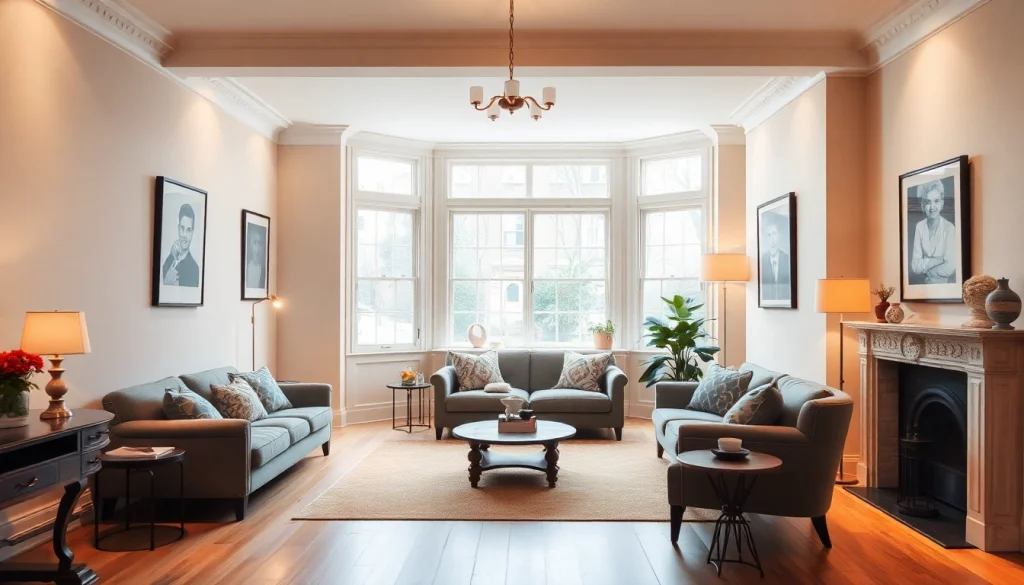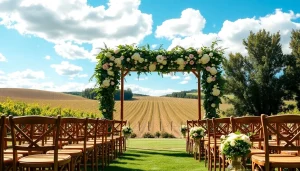Experience the Charm of Bloomsbury: A Journey Through Timeless Elegance and Culture

Understanding the Bloomsbury Aesthetic
The Bloomsbury aesthetic is not just a style; it represents a unique blend of art, literature, and cultural movements that defined an area known for its intellectual and artistic contributions. Located in London, Bloomsbury has long been associated with creativity, avant-garde thinking, and a vibrant community spirit. This article delves into the elements that define the Bloomsbury aesthetic, explores decor ideas inspired by its rich heritage, examines the neighborhood’s cultural significance, and offers insights on how to embrace the Bloomsbury lifestyle.
1.1. Historical Context of Bloomsbury
The Bloomsbury area began its transformation in the early 20th century, home to a group of writers, intellectuals, and artists who became known as the Bloomsbury Group. Prominent figures such as Virginia Woolf, J.M. Keynes, and E.M. Forster championed the idea that art and literature could foster social change and were unafraid to challenge conventional norms. Their radical ideas often clashed with the Victorian values of the previous era, paving the way for modernism in literature and other forms of art.
In addition to its literary significance, Bloomsbury is known for its exquisite Georgian architecture, lush garden squares, and notable educational institutions, such as the British Museum and University College London (UCL). The historical backdrop contributes significantly to the area’s allure and aesthetic, echoing ideals of creativity, innovation, and community.
1.2. Key Characteristics of Bloomsbury Style
Bloomsbury’s style is often characterized by its eclectic mix of colors, textures, and patterns. One of the defining features is the playful use of color, ranging from warm earthy tones to vibrant jewel hues. This penchant for color is inspired by the natural beauty of the surrounding gardens and parks.
Another hallmark is the blend of vintage and contemporary furniture, often showcasing a rich tapestry of fabrics and unusual décor items that reflect the individual personality of the space. Layering different textures—like linen, velvet, and patterns—creates an inviting atmosphere that embodies comfort and creativity, much like the intellectual pursuits of its residents.
1.3. The Influence of Art and Literature
Art and literature have profoundly shaped the Bloomsbury aesthetic. The art movements of the early 20th century encouraged a break from tradition, leading to the adoption of new styles, such as abstraction and modernism. The Bloomsbury Group’s commitment to artistic expression intertwined with their literary pursuits, influencing authors and artists alike.
Moreover, the area’s numerous galleries and spaces showcasing both classic and modern art contribute to an ongoing dialogue about the role of creativity in society. Such influences are evident in the interiors of Bloomsbury homes, where artwork is not merely a decorative element but an integral part of the inhabitants’ identity and daily lives.
Decor Ideas Inspired by Bloomsbury
2.1. Color Palettes That Reflect Bloomsbury Spirit
A Bloomsbury-inspired color palette draws inspiration from both the natural surroundings and the artistic heritage of the neighborhood. Deep greens, rich blues, and warm terracotta create a warm, inviting atmosphere that is rooted in nature. To evoke the Bloomsbury spirit in your home, consider using accent walls painted in rich, bold colors paired with softer, neutral furnishings.
For instance, a living room could feature a deep emerald green wall adorned with abstract paintings, offset by light-colored sofas and colorful throw pillows. This combination creates visual interest while still promoting a sense of relaxation and comfort.
2.2. Furniture Selection for a Bloomsbury Home
When choosing furniture for a Bloomsbury-inspired home, aim for pieces that balance comfort and functionality while showcasing artistic flair. Vintage or vintage-inspired furniture, such as mid-century modern chairs or ornate wooden tables, can add character and sophistication to the space.
To elevate the interior design, mix various eras of furniture, combining traditional pieces with modern shapes. For example, pair a classic Victorian settee with contemporary abstract coffee tables for an interesting juxtaposition. Opt for upholstered furniture in vibrant fabrics or unique patterns—think bold florals or geometric designs—to encapsulate the playful spirit of Bloomsbury.
2.3. Incorporating Art into Your Space
Art plays a pivotal role in creating a Bloomsbury-inspired interior. It is essential to curate a collection that resonates with personal tastes while reflecting the aesthetic values of the bloc. Displaying a mix of original art and printed reproductions can enhance visual diversity and make a statement.
Gallery walls with an eclectic mix of frames, styles, and sizes are a hallmark of Bloomsbury style. Consider including framed prints of famous Bloomsbury Group artworks alongside personal photographs or travel art. Use lighted picture rails to highlight significant pieces and transform your home into a living gallery.
The Bloomsbury Neighborhood: A Cultural Hub
3.1. Must-Visit Landmarks in Bloomsbury
Bloomsbury is rich with cultural landmarks that reflect its fascinating history and ongoing contributions to the arts. A must-visit is the British Museum, which not only houses a world-class collection of artifacts but also embodies centuries of artistic heritage.
Another significant site is Gordon Square, a beautiful garden square surrounded by cafes, bookshops, and educational institutions. It is a perfect spot to unwind or to delve into a good book, fully embracing the intellectual vibe of the area.
Moreover, the Charles Dickens Museum provides insights into the life and works of one of England’s most celebrated authors and showcases the environment that inspired his narratives.
3.2. Exploring the Arts Scene
The Bloomsbury arts scene is vibrant and diverse, marked by numerous galleries, theater productions, and art collectives. The area’s theaters, such as the Bloomsbury Theatre, offer a range of performances from classical plays to contemporary works, spotlighting local talents and international artistry.
Additionally, the annual Bloomsbury Festival brings together the community to celebrate arts and culture through workshops, performances, and exhibitions, fostering creativity and collaboration among participants of all ages.
3.3. Local Dining and Shopping Experiences
Dining in Bloomsbury is an experience that mirrors its eclectic atmosphere. The area boasts a variety of eateries, from upscale restaurants to charming cafes. Visitors can indulge in sumptuous meals inspired by international cuisines and fresh local produce.
Exploring Bloomsbury’s quaint shops is another must-do; from bookshops filled with rare finds to boutique stores offering handcrafted goods, each visit reveals something new. The presence of several publishers, classic bookstores, and art supply establishments further enriches the shopping experience, making Bloomsbury a place where art lovers can truly thrive.
Living the Bloomsbury Lifestyle
4.1. Community Events and Activities
The Bloomsbury lifestyle revolves around a strong sense of community that embraces creativity and diversity. Regular community events, including literary readings, art exhibitions, and workshops, promote engagement among residents and visitors alike.
Participating in local initiatives, such as community gardening projects or arts festivals, allows individuals to connect with their neighbors and contribute to the area’s rich cultural tapestry. These events not only reflect the spirit of Bloomsbury but also enhance the quality of life for all who experience them.
4.2. Gardening Tips for a Bloomsbury Look
Gardening in the Bloomsbury style emphasizes the use of colorful flowers and lush greenery that resonate with the aesthetic values of the area. Start with a mix of perennials and annuals to create a garden bed that blooms throughout the seasons. Vibrant flowers like dahlias, hydrangeas, and roses are excellent choices for achieving the Bloomsbury look.
Incorporate garden seating areas with vintage-style furniture, inviting leisurely afternoons spent with a book or a cup of tea. Raised beds and container gardening can also provide a touch of English charm, allowing city dwellers to embrace nature even in limited spaces.
4.3. Sustainable Living in Bloomsbury Style
Sustainability is increasingly important in the Bloomsbury lifestyle, intertwining with the area’s heritage of social responsibility and innovation. Implementing eco-friendly practices, such as using recycled materials, choosing sustainable furniture, and supporting local artisans, aligns with the Bloomsbury ethos.
Emphasizing local produce in meal planning or participating in community-supported agriculture (CSA) programs not only helps reduce ecological footprints but also fosters a connection to the local community and its resources. Living sustainably in Bloomsbury honors its historical roots while paving the way for a responsible future.
Planning Your Visit to Bloomsbury
5.1. Best Times to Experience Bloomsbury
Visiting Bloomsbury offers unique experiences throughout the year, but spring and summer stand out as the best times to explore the area. During these seasons, gardens are in full bloom, and outdoor events are plentiful, allowing for a vibrant cultural experience.
The annual Bloomsbury Festival, typically held in October, celebrates the community’s artistic heritage, making it another excellent time for visitors to immerse themselves in local culture.
5.2. Accommodation Options in Bloomsbury
Bloomsbury offers diverse accommodation options that reflect the area’s character. From luxurious hotels to quaint bed-and-breakfasts and self-catering accommodations, there is something for every type of traveler. Selecting a stay at one of Bloomsbury’s charming hotels allows visitors to be centrally located, offering easy access to cultural landmarks and dining options.
For a more immersive experience, consider booking a serviced apartment that captures the essence of Bloomsbury living, allowing you to enjoy space, comfort, and a taste of local life.
5.3. Navigating Bloomsbury: Tips for Travelers
Navigating Bloomsbury is straightforward. The area is well served by public transportation, including the Underground and numerous bus routes. Walking is encouraged, as many of Bloomsbury’s attractions are located close to one another, allowing visitors to soak in the architecture and ambiance.
For a more personalized experience, consider joining guided walking tours that delve into Bloomsbury’s rich history and artistic heritage. These tours often reveal hidden gems and stories that may not be readily accessible through standard guidebooks.







